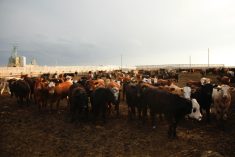Compared to last week, western Canadian feeder cattle markets traded $3 lower to $3 higher. Prices were generally steady to $3 higher on Friday after the U.S. Department of Agriculture lowered its estimate for second-quarter beef production by 125 million lbs. in Thursday’s world agricultural supply and demand estimates (WASDE).
Fed and feeder cattle futures responded immediately, and this set a positive tone to the cash trade. Buying interest increased for yearlings that will be ready for processing from March through May. Earlier in October, one couldn’t give away 550- to 650-pounders but last week, these feeders seemed to jump about $5 from Monday through Friday.
Read Also

U.S. grains: Wheat futures rise on supply snags in top-exporter Russia
U.S. wheat futures closed higher on Thursday on concerns over the limited availability of supplies for export in Russia, analysts said.
Weather has been optimal but almost too warm in some parts of the Prairies. The risk discount due to “long-distance shipping” evaporated and there were instances where Manitoba values were at a slight premium to Alberta. Buyers were willing to pay $2-$4 premiums for weaned or semi-weaned calves on some type of health program. After the prolonged period of negative margins, there is no surge in year-end buying.
In central Alberta, a small group of larger-frame, medium- to lower-flesh steers weighing 920 lbs. were valued at $174 and similar-quality Angus-blended heifers weighing 910 lbs. reportedly sold for $155. In the Lethbridge area, Charolais-based steers with medium flesh averaging 855 lbs. were valued at $184 landed in the feedlot; larger-frame Simmental mixed heifers averaging 810 lbs. were quoted at $166 in the same area.
Solid buying interest was noted on lighter calves in Manitoba last week while demand seemed sluggish on lightweight bawlers in Alberta. North of Calgary, a small group of mixed steers weighing just over 500 lbs. sold for $220 and northwest of Winnipeg, a group of red white-face steers averaging 520 coming straight off their mothers sold for $230. In southern Alberta, semi-weaned vaccinated Charolais-based medium-flesh steers were quoted at $194 delivered feedlot and similar-quality heifers were valued at $178. Larger-frame black weaned calves with full health program averaging 750 lbs. were valued at $188 in central Saskatchewan.
Feed barley prices continue to percolate higher for both old- and new-crop positions. There are drought forecasts surfacing for the western half of the U.S. Midwest and the eastern Prairie regions of Western Canada. Feedlots that didn’t book their feed grains earlier in fall appear to be sitting on their hands. There is a bit of hope in the market going forward. U.S. second-quarter beef production is expected to come in slightly below 2019 and COVID vaccinations should be widespread by the spring period. Beef demand should resume some type of normalcy.
— Jerry Klassen manages the Canadian office of Swiss-based grain trader GAP SA Grains and Produits Ltd. and is president and founder of Resilient Capital, specializing in proprietary commodity futures trading and market analysis. Jerry consults with feedlots on risk management and writes a weekly cattle market commentary. He can be reached at 204-504-8339 or via his website at ResilCapital.com.














